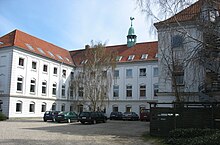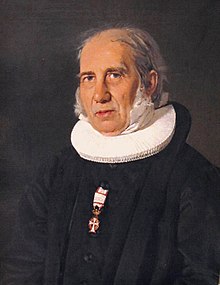Efterskole


The Efterskole (directly translated after school , in German also youth home adult education center, advanced training school or "youth school") is a free school form in Denmark for young people between 14 and 18 years.
The after-schools are a counterpart to the Folkeskole (Danish: Folkehøjskole or Højskole ) aimed at young people . However, the after-school classes are a Danish peculiarity that is unknown in the other Scandinavian countries. There are around 250 after-school schools in Denmark and around 25,000 pupils attend each year. The name Nachschule is based on the fact that when it was founded in Denmark there was a seven-year compulsory education and these schools offer continued teaching from the 8th grade.
Similar to the Folkeskole, all after-schools are free boarding schools , where the coexistence between the students plays a central role. The schools see it as their task not only to design school lessons, but to support the overall development of the individual pupil. Alternative teaching and creative subjects often play a bigger role than in the public school system (compare education system in Denmark ). The after-school schools offer a variety of views on life and subjects, but most of the schools have sprung from the liberal tradition of the folk high school movement .
The schools are self-sustaining, but in some cases linked to a general organization (e.g. Christian, church, scout or worker organizations). The schools are funded mainly through government grants and are supervised by the Ministry of Education .
history
The after-schools emerged in the 19th century from the circles around the Danish folk high school movement. Important people behind it were the pastor Nikolai Frederik Severin Grundtvig and the pedagogue Christen Kold . That is why many free schools and after-schools call themselves "Grundtvig-Kold'sch", a term that indicates a commitment to free values, free education, education and participation in democracy. The teaching of Nordic mythology , biblical history , national history and literature were also focal points of the Grundtvig tradition, but these topics mostly play a smaller role today than they used to.
Schools used to be geared towards the rural population, with a small proportion of “problem young people” from the big cities. At that time, a focus was on agriculture and household lessons for boys and girls. Even today, most of the after-school schools are located in villages or rural areas, which is considered beneficial for the development of a good community among students.
The first secondary school was founded in Ryslinge on Funen in 1851 . After Schleswig went to Prussia in 1864 , a number of secondary schools were built north of the new German-Danish border from 1874. These were set up as boarding schools in order to enable Danish students from northern Schleswig to attend a Danish school without having to cross the border every day.
Galtrup Efterskole was founded on the island of Mors in North Jutland in 1879 and is the oldest secondary school still in existence today.
In 1930 the first law on post-schooling was passed. Accordingly, the schools receive state subsidies, which enabled pupils from broader circles to attend post-school.
In the 1960s, the number of students in the after-school classes decreased. It was therefore considered whether one should leave the school form of the Heimvolkshochschule and change the secondary schools in the direction of the public elementary school (with a fixed workload and exams). In 1967, after-school classes were allowed to take some publicly recognized exams, and since 1975 after-school classes have been allowed to offer all elementary school exams. Since then, the after-school classes have abandoned the informal tradition of the folk high school movement, but the particular way of life and the idea of “learning for life” lives on. The individual secondary schools try to balance between the traditional vision of the free schools, the demands of the Danish state and various educational ideas.
From 1975 to 2000 the number of secondary schools doubled, as did the number of pupils each year. In 1996 the law was tightened so that only free and independent post-schools can receive state subsidies. The background was the exploitation of the previously very liberal legislation by the Tvind school empire, which let public grants migrate to a community fund. The Tvind schools then lost their state funding.
Since the year 2000, every after school has had to describe its specific basic values and goals. A critical self-evaluation must take place at the end of each school year. These innovations are similar to rules that have been introduced in the rest of the school system and in the public sector.
Pedagogy and everyday life
Today the after-schools are attended by students from all segments of the population. Pure boys - or girls' schools are very rare. The range of subjects mostly includes general school subjects, often with expanded options for creative subjects such as art, theater or sport.
An increasing number of after-school schools are aimed specifically at students with special interests such as B. Outdoor sports, gymnastics, environmental studies, music, sailing, fishing, agriculture, languages, chess, role play, film or computers. Similar to the case of folk high schools, this profiling is often a necessity in order to adapt to the interests of young people. Accordingly, some after-school schools have been given high quality equipment.
Some schools are geared towards dyslexics , the blind , the learning disabled or other functionally handicapped people , while these groups of students from other schools are integrated with other students. A very small part of the after-school classes put the main emphasis on theoretical subjects with a teaching program that is even more “conservative” than the Danish elementary school.
The average after school has 85 students. Students take part in household chores such as B. Kitchen service and cleaning. On the weekends you can either stay at school (there is often a leisure program) or go home to your parents. However, many schools have certain compulsory weekends where all students are present. Excursions and trips are part of the annual program of most after-school schools.
In terms of discipline, the after-school classes are quite different. Most post-schools follow relatively liberal principles of "freedom and responsibility". The need for clearly defined rules, daily schedules, reading and rest hours varies. Alcohol, drugs (and often smoking) are mostly strictly prohibited. Active participation in class as well as in social life is required.
The day often starts with a morning circle, where songs from the Folkehøjskolens Sangbog (Folk High Schools Songbook) are sung. If necessary, information is provided about social events (in some schools the radio news is played out) and then discussed. School matters can be discussed, in some cases there is a weekly plenum. There are also devotions in Christian schools .
Similar to folk high school teachers, teachers have different backgrounds, ranging from general teacher training to academic backgrounds and employment. Most of the time the teachers (or some of them) live in the after-school or in the immediate vicinity.
While some schools are limited to one school year, others offer classes from 8th to 10th (possibly 11th) grades. Most students stay at school for only one year.
Youth schools
Some after-schools traditionally call themselves Ungdomsskole (“youth school”), but do not differ from the other after-schools. However, this designation can also refer to municipal recreational lessons for 14 to 18 year olds.
Grades and exams
While the absence of grades and exams was once a matter of the heart for the free schools, most post-schools have long since adapted in this respect to the public school system. But the question is not undisputed.
The vast majority of schools offer the completion of the 9th or 10th grade of the Danish elementary school ( Folkeskolen ) so that the stay can be fully integrated into the rest of the school system.
A small minority of the after-school classes adhere strictly to the tradition of the folk high school movement, since free instruction, the “living word” and the development of the “whole person” are incompatible with exams. These schools therefore do not offer any exams. However, if they wish, students can take exams at another school (after school, free or public school) nearby and obtain a degree.
Greenlandic students
The geography of Greenland limits school opportunities for many Greenlanders. Over 200 Greenlandic students attend a Danish secondary school every year.
Economy
The parents pay for the stay. However, state subsidies can be received, the amount of which depends on the parents' income. In some cases, the student's community of residence also pays an additional grant.
With a gross school fee of Kr. 1600 (€ 215) per week, the lowest personal payment is Kr. 640 (€ 86) per week (with an annual income of the parents below Kr. 295,000 (€ 39,700)). The highest personal payment in this case is Kr. 1123 (€ 151) per week (if the parents have an annual income of more than Kr. 820,000 (€ 110,350)).
Secondary schools for the minorities in the German-Danish border area
Every year around 120 students from Germany (mostly from the Danish schools in southern Schleswig) take part. As a rule, they are run by the Danish School Association for South Schleswig , such as Ladelund Ungdomsskole , which is a Danish-style after school. The school was founded in 1982 and since then has had an average of 55 students a year, mainly from the Danish schools in southern Schleswig, but around five students from Denmark also attend the school each year. Most students leave school with a secondary school leaving certificate according to the Schleswig-Holstein curriculum.
North of the border, the German secondary school Tingleff is run by the German minority in Northern Schleswig . The school was originally founded as a folk high school in 1905, but has functioned as a post-school since 1951. Every year around 100 pupils attend the school, half of them from Denmark and half from Germany, and there are mostly 3-5 pupils from third countries. A central offer of the school is German lessons in bilingual everyday life. After the 9th grade, the student has the Danish "Folkeskole" qualification and the German secondary school qualification if the exam is passed . The completion of the 10th grade corresponds to the German secondary school leaving certificate .
See also
Web links
- The Danish Efterskole. (Danish, English).
- A film about the efterskole (in English)
Individual evidence
- ^ The historical development of the Efterskole. (No longer available online.) In: www.efterskole.dk. Formerly in the original ; accessed on April 1, 2020 . ( Page no longer available , search in web archives )
- ↑ Facts about the Danish Efterskole. (No longer available online.) In: www.efterskole.dk. Formerly in the original ; accessed on April 1, 2020 (English). ( Page no longer available , search in web archives )
- ^ Greenlandic pupils in secondary schools. (No longer available online.) In: www.efterskole.dk. Formerly in the original ; accessed on April 1, 2020 (Danish). ( Page no longer available , search in web archives )
- ↑ Economics school year 2008-09. (No longer available online.) In: www.efterskole.dk. Formerly in the original ; accessed on April 1, 2020 (Danish). ( Page no longer available , search in web archives )
- ↑ As of January 13, 2009, exchange rate DKK → EUR 0.1346
- ↑ after school. In: www.skoleforeningen.org. Efterskoleophold | Dansk Skoleforening for Sydslesvig eV, accessed on February 19, 2020 (German).
- ↑ After-school and extra-curricular institutions, Grenzlandportal. (No longer available online.) In: www.graenselandsportal.eu. Formerly in the original ; accessed on April 1, 2020 . ( Page no longer available , search in web archives )

